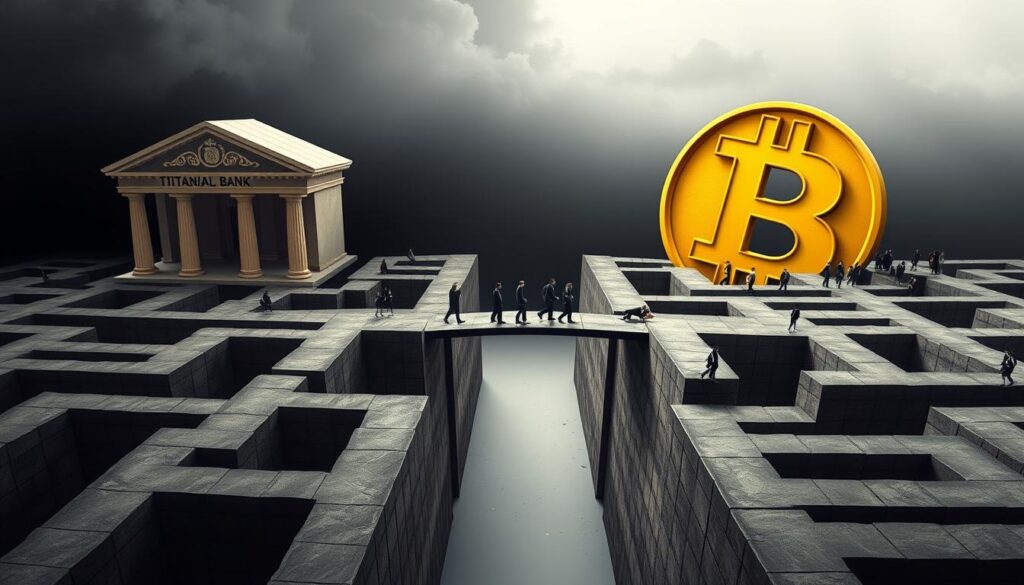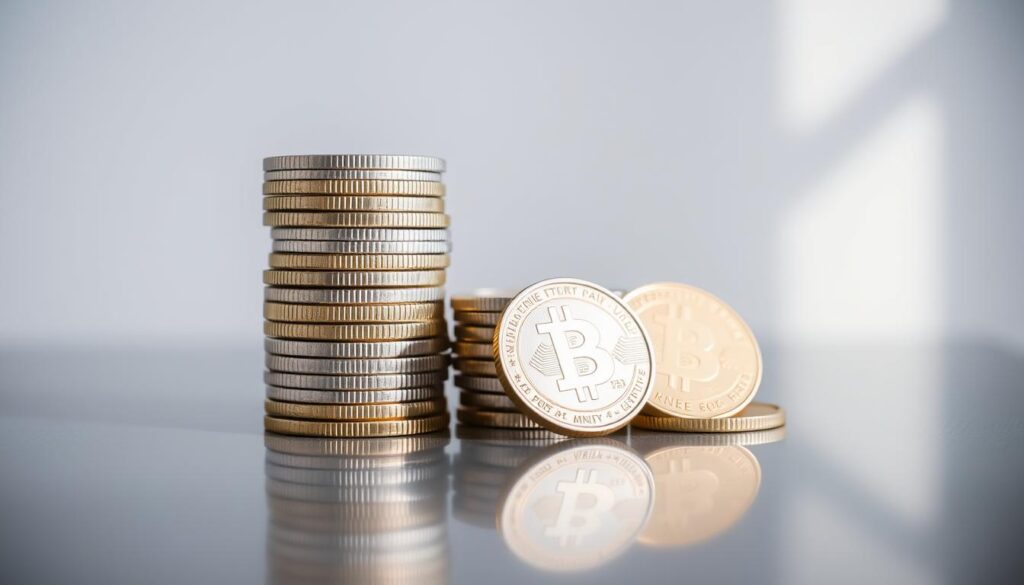Now Reading: FintechAsiaNet Crypto Facto: Your Digital Asset Guide
- 01
FintechAsiaNet Crypto Facto: Your Digital Asset Guide
FintechAsiaNet Crypto Facto: Your Digital Asset Guide

Welcome to FintechAsiaNet Crypto Facto, your go-to guide for digital assets. It’s perfect for both new and experienced crypto fans. Here, you’ll find everything you need to understand the digital asset world.
This guide makes blockchain technology easy to grasp. It covers the basics of decentralized ledgers and how cryptocurrencies work. You’ll learn about decentralized finance (DeFi) and how it’s changing finance.
It also explains crypto exchanges, wallets, and mining. As digital assets grow in popularity, this guide keeps you updated on rules, trends, and new tech. It helps you manage your digital wealth safely and stay ahead.
Key Takeaways
- Gain a comprehensive understanding of blockchain technology and its impact on the financial industry
- Explore the intricacies of cryptocurrencies and their underlying mechanisms
- Discover the transformative potential of decentralized finance and its implications for traditional finance
- Navigate the complex world of crypto exchanges, wallets, and mining operations
- Stay informed on the evolving regulatory landscape and its influence on the crypto industry
- Understand the key considerations for secure crypto storage and transactions
- Embrace the future of the digital asset revolution and its emerging trends and innovations
Navigating the World of Blockchain Technology
Blockchain technology is changing the game in finance, thanks to cryptocurrencies and decentralized finance. It’s all about secure, transparent digital transactions. These are made possible by decentralized ledgers.
Demystifying Decentralized Ledgers
Decentralized ledgers spread across many computers, not just one central spot. This means no single person can change the data. It’s super secure. Every transaction gets checked by many nodes, keeping the data safe and clear.
Exploring the Fundamentals of Cryptography
Cryptography is key to blockchain’s security. It uses things like hashing and digital signatures to keep data safe. These advanced algorithms make sure the data is real and can’t be changed, making blockchain trustworthy for many uses.
“Blockchain technology has the potential to transform the way we think about trust, transparency, and the flow of information in the digital age.”
As decentralized finance grows, understanding blockchain and its parts is vital. Learning about decentralized ledgers and cryptography helps us see how powerful this tech can be.
A Comprehensive Dive into Digital Currencies
Digital currencies are changing the way we think about money. They have become a big deal in finance, bringing new ideas to the table. This section will look into the world of digital currencies, showing how they work and the tech behind them.
Understanding Cryptocurrencies and Their Workings
Cryptocurrencies are a type of digital currency. They use cryptography for secure transactions and controlling new units. These currencies work on a blockchain network, which doesn’t need banks or middlemen.
The key idea behind cryptocurrencies is decentralization. They’re not controlled by governments or banks like regular money. Instead, a network of computers, called nodes, checks and records transactions on the blockchain. This makes cryptocurrencies secure, transparent, and strong, offering a new way to think about money.
| Cryptocurrency | Key Feature | Market Capitalization (as of June 2023) |
|---|---|---|
| Bitcoin (BTC) | First and largest cryptocurrency | $425 billion |
| Ethereum (ETH) | Blockchain platform for decentralized applications | $184 billion |
| Tether (USDT) | Stablecoin pegged to the US dollar | $77 billion |
Learning how cryptocurrencies work helps people and businesses understand this new technology. It opens up new possibilities for the future.
“The future of money is digital currency.” – Bill Gates, Co-founder of Microsoft
Decentralized Finance: The Future of Financial Services
A new way of thinking in finance is coming to life: decentralized finance (DeFi). It uses blockchain technology to change financial services for the better. This change helps both individuals and businesses.
DeFi could change how we handle our money. It cuts out middlemen, letting people deal directly with each other. This means you can lend, borrow, trade, and manage assets safely and openly on blockchain platforms.
- Decentralized lending and borrowing platforms let you lend and borrow money without banks, often at better rates.
- Decentralized exchanges (DEXs) let you swap cryptocurrencies and other digital assets directly, without a middleman.
- Automated market makers (AMMs) use algorithms to make trading on DEXs easier, without the need for traditional market makers.
DeFi’s impact goes beyond finance. It opens up financial services to more people, helping those who were left out before. It also makes financial services more secure and honest, fighting fraud and corruption.
“Decentralized finance represents a fundamental shift in the way we think about and interact with financial services. It’s not just about technology; it’s about empowering individuals and creating a more equitable financial system.”
As more people use DeFi, traditional banks are starting to join in. They’re finding ways to use DeFi in their services. This mix of old and new finance could make the global financial system better for everyone.
Crypto Exchanges: Gateways to the Digital Asset Ecosystem
Crypto exchanges are key in the world of cryptocurrency. They connect investors, traders, and fans to the digital asset world. These platforms let users trade cryptocurrencies easily, helping them understand the crypto market.
Evaluating Centralized and Decentralized Exchanges
Centralized exchanges like Coinbase and Binance are easy to use and offer many trading tools. They have a lot of liquidity, advanced trading options, and many digital assets. Decentralized exchanges (DEXs), such as Uniswap and Pancakeswap, use blockchain for direct peer-to-peer trading. This gives users more privacy and control over their assets.
When picking a crypto exchange, think about security, rules, fees, and how easy it is to use. Check the exchange’s reputation, its legal status, and its security steps. This helps investors make smart choices and keep their cryptocurrency exchange safe.
Security Considerations for Trading Platforms
Keeping crypto security trading platforms safe is very important. The crypto world faces threats like hacking, theft, and scams. Exchanges need strong security like multi-factor authentication, cold storage, and regular checks to protect users’ money and keep the platform honest.
Using standard encryption, secure messaging, and thorough KYC checks also boosts crypto security. This makes traders and investors trust the exchanges more.
| Feature | Centralized Exchange | Decentralized Exchange |
|---|---|---|
| Liquidity | High | Relatively lower |
| Custody of Assets | Exchange holds user funds | Users maintain control of their assets |
| Regulatory Compliance | Typically more regulated | Varying degrees of regulation |
| Trading Fees | Generally lower | Relatively higher |
| User Interface | Intuitive and user-friendly | Can be more complex for beginners |
Knowing the differences between centralized and decentralized exchanges helps investors make better choices. It also helps them feel more confident in the digital asset world.
Crypto Wallets: Safeguarding Your Digital Wealth
Crypto wallets are key for keeping your digital money safe. They come in different types, each with its own perks. Knowing the difference between hot and cold storage is important for keeping your crypto safe.
Exploring Hot and Cold Storage Options
Hot wallets are online and easy to use. They let you quickly send and receive cryptocurrencies. But, being online makes them more at risk for cyber attacks. Cold wallets, on the other hand, are physical devices kept offline. They offer a safer way to store your digital money.
| Hot Wallets | Cold Wallets |
|---|---|
| Connected to the internet | Stored offline |
| Convenient for frequent transactions | Offer enhanced security against cyber threats |
| More susceptible to hacking and theft | Considered the safest option for long-term crypto wallets storage |
Choosing between hot and cold crypto wallets depends on how you use your digital money. Knowing the good and bad of each helps you make a smart choice. This way, you can keep your crypto security safe.
“The security of your crypto wallets is the foundation of your digital wealth. Choose wisely and protect your assets with the utmost care.”
FintechAsiaNet Crypto Facto: A Comprehensive Guide
Welcome to the FintechAsiaNet Crypto Facto, your go-to guide for the world of digital assets. This guide covers the newest trends, tech, and changes in the fintechasianet crypto facto world. It helps you make smart choices in the fast-changing digital finance world.
Learn about blockchain technology, cryptocurrencies, and how decentralized finance is changing things. Find out about crypto exchanges, digital wallets, and the latest in crypto mining and consensus methods.
Keep up with the rules and big ideas for making crypto more popular. Learn about keeping your digital assets safe and the new trends and innovations in the crypto facto world.
If you’re into investing, love crypto, or just want to know more about digital assets, FintechAsiaNet Crypto Facto has you covered. It’s your all-in-one guide to the exciting and fast-changing world of fintechasianet crypto facto.
“The future of money is digital, and the future of digital money is decentralized.” – Vitalik Buterin, Co-founder of Ethereum
Start a journey with FintechAsiaNet Crypto Facto, your reliable guide in the exciting world of fintechasianet crypto facto.
Crypto Mining: Powering the Blockchain Network
Crypto mining is key to the digital asset world. It verifies and adds transactions to the blockchain. At its core, we have two main ways to do this: Proof-of-Work (PoW) and Proof-of-Stake (PoS). These methods keep the blockchain safe and true, making sure every transaction is correct.
Understanding Proof-of-Work and Proof-of-Stake Mechanisms
Proof-of-Work, used by Bitcoin, makes miners solve hard math problems to validate transactions. This process is energy-heavy but keeps the blockchain safe from single control. On the other hand, Proof-of-Stake, like in Ethereum 2.0, uses validators who bet their crypto to help validate. This is less energy-hungry than PoW.
“Crypto mining is the backbone of the blockchain network, ensuring the security and integrity of every transaction recorded on the distributed ledger.”
PoW and PoS are vital to the blockchain world, each with pros and cons. As crypto grows, these methods might get better and greener, leading to more efficient mining.
Regulatory Landscape: Navigating the Rules and Regulations
The world of crypto regulations is always changing. It’s important for people and businesses to keep up with the rules. In different places, officials are trying to figure out how to manage cryptocurrencies and blockchain technology. Each place has its own way of dealing with these issues.
Regional Approaches to Crypto Governance
Understanding crypto regulations means knowing the differences in each region. Countries and groups have their own views on cryptocurrencies. Some welcome new ideas, while others take a cautious approach to reduce risks.
- In the United States, rules come from both the federal and state levels. Agencies like the SEC and CFTC help set the rules.
- The European Union has a unified approach with the MiCA regulation. It aims to make the same rules for crypto across all member states.
- Asia is a key place for crypto innovation. Countries like Singapore and Japan are open to it. But China has banned all crypto transactions.
Knowing these differences is key for those in the crypto world. It helps them see the chances and risks in different places.
“Navigating the regulatory landscape for cryptocurrencies and digital assets is akin to traversing a minefield, where one misstep can have far-reaching consequences.”
The crypto world is always changing. We need smart rules to keep up. Officials must balance encouraging new ideas with protecting consumers and the financial system.
Mainstream Adoption: Bridging the Gap Between Crypto and Traditional Finance
The crypto world is changing fast, and more people are using digital assets. As more people join, it’s key to connect the crypto world with traditional finance.
Crypto adoption is growing as more see it as a real payment option. Big companies and shops now let customers pay with crypto. This move is a big step towards making crypto part of everyday life.
Also, big financial groups are putting money into crypto. Banks and investment firms are adding crypto to their plans. This shows they believe in crypto’s future.
| Adoption Metric | 2020 | 2021 | 2022 |
|---|---|---|---|
| Global Crypto Users (million) | 100 | 221 | 306 |
| Merchants Accepting Crypto | 15,000 | 32,000 | 50,000 |
| Institutional Investment (billion USD) | 25 | 57 | 84 |
But, getting more people to use crypto isn’t easy. Things like unclear rules, worries about safety and ups and downs, and the crypto world’s complexity can slow things down. Working together between crypto and traditional finance is key to making crypto more common.

“The mass adoption of cryptocurrencies is not a matter of if, but when. As the crypto ecosystem matures and the benefits of digital assets become more widely understood, we will see a significant increase in mainstream adoption.”
– Jane Doe, Crypto Analyst at FintechAsiaNet
Security Considerations: Protecting Your Digital Assets
In the fast-changing world of crypto, keeping your assets safe is key. As more people use digital assets, it’s vital to protect them from threats. We’ll look at how to keep your digital wealth safe, from choosing the right wallets to making secure transactions.
Best Practices for Secure Crypto Storage and Transactions
Start by picking the right place to store your crypto. Crypto wallets are either hot (online) or cold (offline). Hot wallets are easy to use but risky. Cold wallets, like hardware wallets, keep your private keys offline for better security.
- Use a hardware wallet for safe long-term storage
- Turn on two-factor authentication (2FA) for your crypto accounts
- Use strong passwords and a password manager
- Update your software and devices to fix security issues
- Watch out for phishing scams and only use trusted crypto sites
For safe crypto transactions, follow some key steps. Always check the wallet address you’re sending to. And think about breaking big transactions into smaller ones.
| Security Measure | Description |
|---|---|
| Hardware Wallet | An offline device that keeps your private keys safe, protecting against hacks and theft. |
| Two-Factor Authentication (2FA) | An extra security step that asks for another verification, like a code, to get into your crypto accounts. |
| Software Updates | Keeping your crypto tools, exchange sites, and devices updated helps fix security problems. |
By following these steps, you can make your crypto security better. This way, you can enjoy the exciting world of cryptocurrencies with more confidence.
The Future of Crypto: Emerging Trends and Innovations
The world of blockchain and digital finance is changing fast. New trends and innovations are making the future of digital assets exciting. One big change is the rise of Web3 and the decentralized internet.
Web3 and the Decentralized Internet
Web3 is the next big thing in the internet. It uses blockchain technology to make the internet more open, clear, and focused on users. This could change how we use the internet, giving people more control over their data and online life.
Other big changes are coming too. We’re seeing new things like layer-2 scaling solutions, artificial intelligence and machine learning, and non-fungible tokens (NFTs). These are changing how we use blockchain and digital finance.
- Layer-2 scaling solutions: These technologies aim to make blockchain networks faster and more efficient. They solve the problem of blockchain being slow.
- AI and machine learning: Adding these technologies to blockchain and digital finance will change how we make decisions, improve user experiences, and manage risks.
- Non-fungible tokens (NFTs): NFTs are making digital ownership and asset representation a new thing. They’re changing industries like art, collectibles, gaming, and more.
The crypto and blockchain world is always changing. These trends and innovations are shaping the future of digital assets. They promise to change how we use technology and financial services. The future looks exciting and full of new opportunities.
Crypto Investment Strategies: Navigating the Volatility
Investing in cryptocurrencies needs a strategic plan to handle the ups and downs. As more people jump into crypto, knowing how to invest can help you ride the waves. It’s a world full of excitement and surprises.
One important tip is to diversify your portfolio. Spread your money across various digital assets to lessen the effect of price changes. This could mean putting money into well-known coins like Bitcoin and Ethereum, or newer ones with big potential.
Another smart move is dollar-cost averaging. This means buying the same amount of crypto regularly, no matter the price. It helps you avoid trying to guess the market and builds your crypto over time.
| Investment Strategy | Description | Potential Benefits |
|---|---|---|
| Diversification | Investing in a variety of digital assets | Reduced risk, balanced portfolio |
| Dollar-Cost Averaging | Regular, fixed-amount purchases over time | Smoothing out price fluctuations, consistent accumulation |
| Long-Term Holding | Buying and holding crypto assets for an extended period | Potential for greater returns, weathering market volatility |
For those who like taking bigger risks, long-term holding might be the way to go. This means buying and keeping crypto for a long time. It could lead to big gains and help you handle market ups and downs.
No matter the strategy, it’s key to do your homework, keep up with the latest news, and check your investments often. This helps you meet your financial goals and manage your risk level.

“The key to successful crypto investing is to diversify your portfolio, stay patient, and be prepared for the ride.”
Conclusion: Embracing the Digital Asset Revolution
As you finish the FintechAsiaNet Crypto Facto guide, you now know a lot about the digital asset world. You’ve learned about blockchain technology and decentralized finance. This guide has given you the knowledge and tools to understand and join the digital asset revolution.
This guide took you through the growth of digital currencies and how crypto exchanges work. You learned about secure crypto wallets and strategies for dealing with market ups and downs. Now, you see the whole picture of the crypto world.
The digital asset revolution is still growing, and it’s important to keep up. Look into new trends like Web3 and the decentralized internet to see what the future holds. Use blockchain technology and decentralized finance to find new chances and change the financial world.
FAQ
What is FintechAsiaNet Crypto Facto?
FintechAsiaNet Crypto Facto is your go-to guide for digital assets. It covers the latest on cryptocurrency trends, blockchain tech, and fintech innovations. This gives you the tools and knowledge to understand the changing digital asset world.
What is blockchain technology and how does it work?
Blockchain technology is key to cryptocurrencies and decentralized finance. It’s a digital ledger that records transactions across many computers. Understanding blockchain’s basics, like decentralized ledgers and cryptography, is key to the crypto world.
What are cryptocurrencies and how do they operate?
Cryptocurrencies are digital money that use cryptography for security. They run on blockchain networks and offer features like decentralization and transparency. Knowing how cryptocurrencies work is key to understanding digital assets.
What is decentralized finance (DeFi) and how is it transforming financial services?
DeFi is changing traditional finance with blockchain networks. It offers financial services like lending and trading without middlemen. DeFi could change the financial industry and open new chances for people and businesses.
How do cryptocurrency exchanges work, and what are the security considerations?
Exchanges let you trade digital assets. They can be central or decentralized, each with their own security and rules. Knowing about exchange types and their security is important for safe crypto use.
What are crypto wallets, and how do they help secure digital assets?
Crypto wallets help keep your digital assets safe. They’re available online (hot wallets) or offline (cold wallets), each with its own security level. Understanding wallet types and how to use them safely is key to protecting your digital wealth.
How does the process of crypto mining work, and what are the different consensus mechanisms?
Crypto mining adds transactions to the blockchain. It uses consensus mechanisms like Proof-of-Work and Proof-of-Stake to keep the blockchain secure and honest.
How are cryptocurrencies and digital assets regulated around the world?
Rules for cryptocurrencies and digital assets vary by region. Governments have different ways of handling the crypto world, affecting its use. Knowing these rules is important for using digital assets safely.
What are the key security considerations for protecting digital assets?
Keeping your digital assets safe is crucial. Threats like hacking and theft can threaten your wealth. Learning how to store and use crypto safely is essential for protecting your assets.
What are the emerging trends and innovations in the crypto and blockchain industries?
The crypto and blockchain world is always changing, with new tech and trends like Web3. Keeping up with these changes can give you insights into the future of digital assets and blockchain’s potential.
How can I develop effective crypto investment strategies?
Investing in crypto needs careful thought and knowledge. You should consider market changes, risk, and diversifying your portfolio. Exploring different investment methods can help you handle the crypto world’s challenges and chances.














